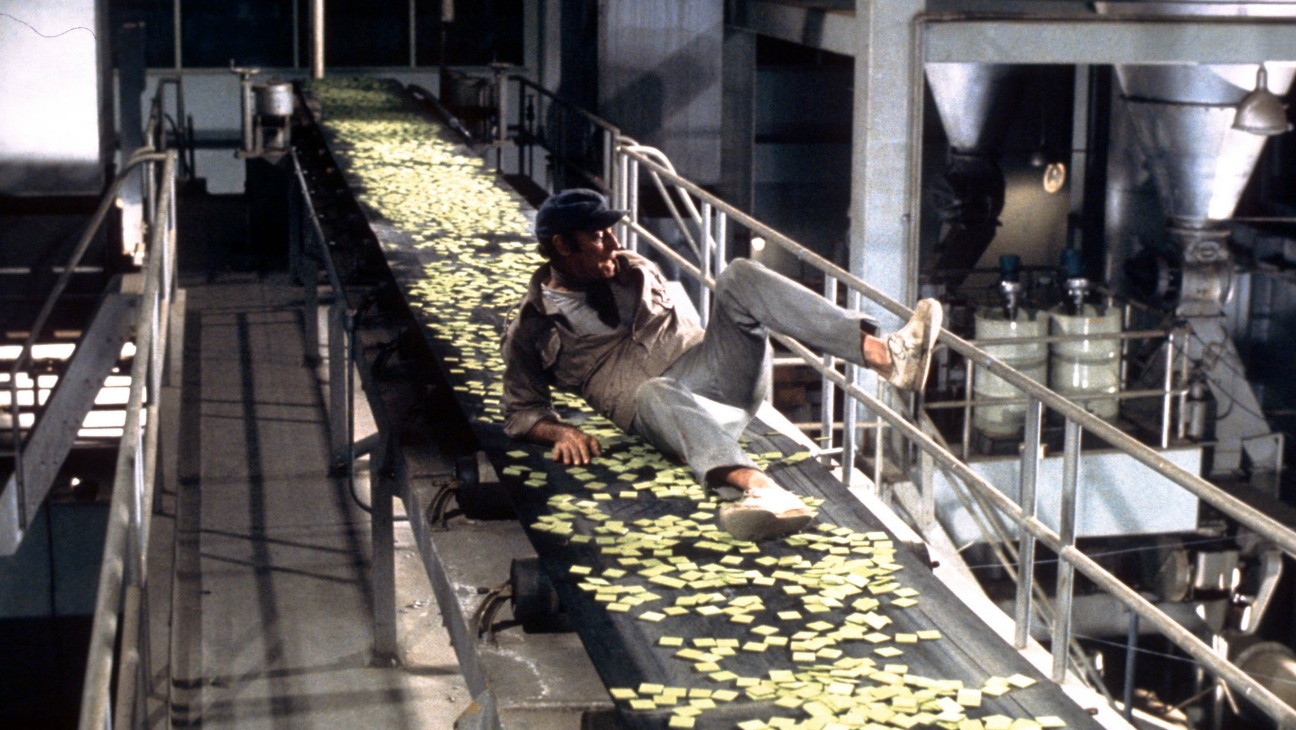According to an old Hollywood commonplace, nothing can beat the plot of a good sci-fi film when it comes to predicting the future. Many of the promotional taglines that accompany these features assure us that, should we invest in a ticket, we’ll be “entertained” and “educated,” or even “enlightened,” by a product that “presciently signifies the all-but-inescapable fate of our planet” (2012), that warns of a future that “looks, feels, and almost tastes and smells like a nightmare vision of our times” (1984), or that offers a “harsh but searingly urgent” glimpse of the overall prospects for mankind (Blade Runner). The general consensus seems to be that this particular type of picture is an important augury for the human race, and that to overlook the message it brings us is to put us a step closer to the unthinkable.
Or at least that’s one version. You could also argue that, for the most part, Hollywood has proved itself to be no more gifted a forecaster of events than Self magazine’s resident astrologer, or for that matter Al Gore confidently informing us that the Arctic would be ice-free by the year 2013. To take merely a few examples of the many available: What happened to the televised fight-to-the-death prison contests promised by 1987’s Running Man? Our TV networks may have debased themselves to sorry levels of late, but at least as of this writing they still fall short of offering actual human sacrifice for the audience’s entertainment. Or what of the similarly dystopian premise of 1981’s Escape from New York? I agree that the picture achieves the right rubble-strewn, anarchic feel of present-day Manhattan, but, again, no cigar for its wider powers of prediction. And for yet another bold guess at the future direction of the U.S. justice system, there’s 1993’s Demolition Man, in which crime has somehow been extinguished from the land, at least until the moment a violent offender escapes his cryogenic deep-freeze to once again unleash havoc upon us. The list is far from exhaustive.
Of course, over the years the movies have also scored one or two limited successes to partially offset the long list of misses. The law of averages would hardly permit a complete zero in terms of a celluloid projection of our collective destiny. There were the personalized messages, eerily like today’s cookie-generated stalker ads that creepily appear on your Facebook feed or pop up on your phone, of Tom Cruise’s 2002 vehicle Minority Report, for example; or the virtual-reality technology prophetically featured in 1992’s Lawnmower Man; or for that matter the unambiguously titled Things to Come (1936), which among other things foresaw the advent of nuclear warfare nearly a decade ahead of its ghastly fulfilment at Hiroshima. The last named film also talks a good deal about the cause of “female preferment,” a term which nowadays seems to mean little more than asking every half-acceptable woman whether she would be prepared to ruin her life by being appointed to the Supreme Court.
Which brings us to the case of the 1973 cult classic Soylent Green, starring Charlton Heston, set in our own benighted Year of Our Lord 2022. The film’s primary action takes place in a particularly dystopian hellscape of an overpopulated, polluted, famine-struck New York City, where the masses line up for their daily rations of water and a cube of the eponymous foodstuff apparently made of a high-energy seaweed substance. But is it? Heston plays a detective called in when one of the city’s bigwigs is murdered, but his real epiphany comes with the movie’s much-parodied punchline, “Soylent Green is people! It’s peeeoooplllle!” There’s a poignant role—his last ever—for Edward G. Robinson, who plays an old soak who remembers how to read books, peddles a rusty bicycle as a way to maintain electricity, and whose rheumy eyes light up when the Heston character presents him with the first solid food he’s seen in years. Most of the women in the film are there for decorative or reproductive purposes, and are unblushingly referred to as furniture. The general idea is of a society teetering perpetually on the brink of collapse, set in the kind of place where most things seem to be made of salvaged oil drums, and where it’s easier to find rotgut whiskey than clean water.
As you watch Soylent Green today, you may find yourself recognizing a certain amount of the film’s apocalyptic vision of American inner-city life as we know it in 2022. Far too many people are living on the street and our shelters are filled with the indigent or mentally ill: check. Most of Manhattan looks uneasily like downtown Berlin after a particularly heavy night in April 1945: check. Heston plays his usual paragon of rugged decency, albeit with one or two lapses, but some of the other authority figures appear more than a trifle heavy-handed in their treatment of the dispossessed: check. Society seems to be at the tipping point of a terminal environmental catastrophe, or at least so many people believe: check. There are those who prefer to walk around the rubble-strewn streets or interact with their fellow human beings from behind a prophylactic cloth mask: check. Sex, and in particular the female body, is treated as just another throwaway consumer commodity: check. And, as an overarching theme to the film, most of the money and power are concentrated in the hands of a tiny elite who believe they have a natural, almost a divine, right to rule: emphatic check.
Long before the shoot-em-up histrionics of Blade Runner, the interminable Mad Max franchise, or Kurt Russell’s bicoastal Escape flummeries, Soylent Green dared to project a vision of the future distinguished not so much by its violence as its squalor. The nearly barren, bombed-out American urban landscape it projects is such a convincingly recognizable one, and the mutant characters who inhabit it so familiar, that it’s hard not to be engaged by the sometimes absurd plot. Edward G. Robinson helps, too—not least because of the rueful irony of watching his character’s lingering death-by-euthanasia scene at the end of the film in the knowledge that Robinson himself succumbed to cancer, age 79, only 12 days after shooting ended.
Soylent Green may not be a perfect blueprint of our present times. Sadly debased as the human condition is, we’ve yet to succumb to wholesale cannibalism, or for that matter to embrace institutionalized assisted-suicide services, although of course these days anything’s possible, and some years ago the voters here in Washington saw fit to pass the state’s so-called Death with Dignity Act. A central premise of the film is the unsustainable rise in the population of New York City, which it puts at 40 million, around five times the actual figure. There’s also the slight problem of Heston, who gives his usual impeccable turn as the last voice of reason, left to look back in anger on a world whose beauty is equaled only by its ability to destroy itself, but who rather disconcertingly dresses as though on audition for a role in the Village People.
Of course, there’s always the possibility that Soylent Green’s director, Richard Fleischer, wasn’t staring into a crystal ball of 2022 when he shot the film so much as he was simply observing the real-life world that lay before him. This was the mid-1970s, after all, some of the darkest, bleakest years in New York’s history. The city was widely perceived as a place of danger, decay, and paranoia, beset by seemingly permanent social and fiscal crises and fighting for its very survival. Soylent Green may fit squarely in the sci-fi pigeonhole, or equally might fall within the definitions of a police drama or a disaster epic, but it could also make a strong bid to be treated as a particularly arresting documentary of its time and place. At the end of the day, it depicts a world so vivid and immediate that two dimensions naturally become three, without the need for any fancy Hollywood stereoscopics. If you’re looking for a beautifully sculpted, often disturbing, sometimes mildly silly, always intriguing picture that actually says something about life in America, both then and now, here is your film.

